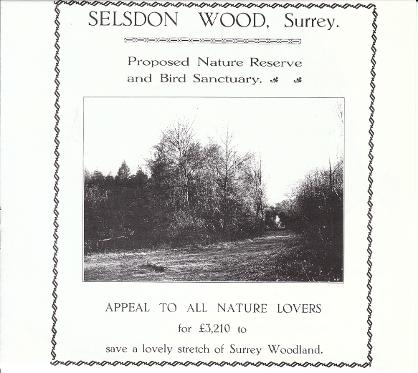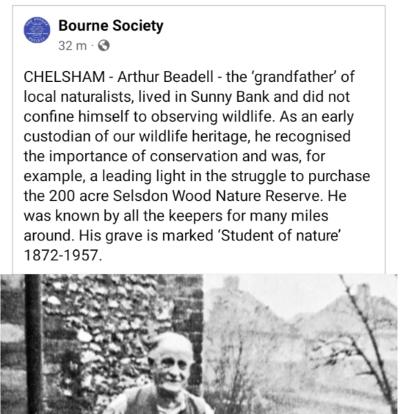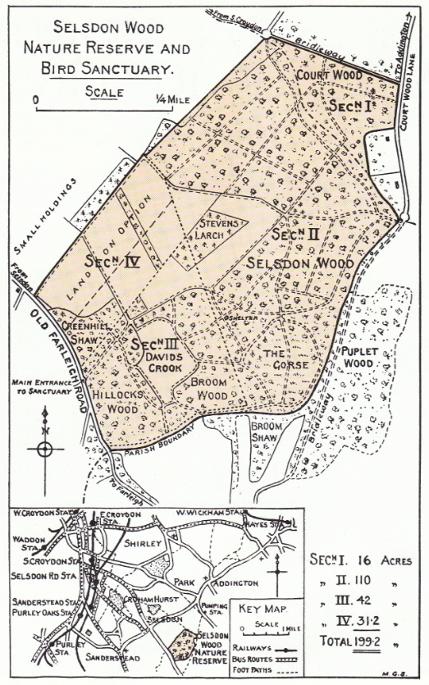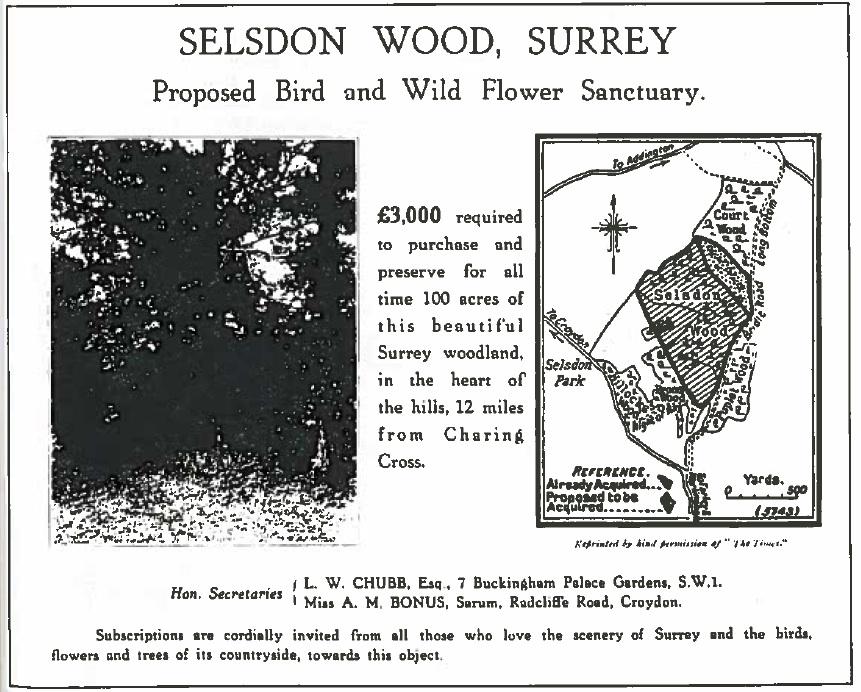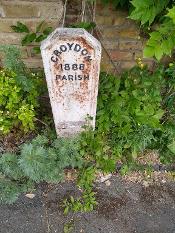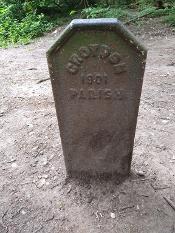
History of the area
The history of the area surrounding Selsdon Woods can be traced back hundreds of years. In the 1950s Mr. R.I. Little excavated a Romano-British settlement in nearby Kings Wood, half a mile to the south-west. A small farmstead and cemetery were discovered which had been undisturbed for 2000 years. Pottery found there indicated occupation from the middle of the first century to the middle of the second century A.D.
The section of Old Farleigh Road on the south west border of Selsdon Woods is an Iron Age track way to the Sussex ironfields via Farleigh, Titsey and Limpsfield Common, and in Kings Wood Mr. Little discovered 46 dene holes or depressions, thought to be marl pits. One 10 foot shaft contained Iron Age pottery. There are many lineal earthworks, which may be ancient field boundaries, similar to the mound and ditch which forms the Addington Boundary in Selsdon Woods.
Origins of Selsdon Wood
Selsdon Wood was once part of the Selsdon Park estate. Selsdon was within the parish of Croydon from medieval times and was part of land owned by the Archbishops of Canterbury. From at least the 16th century Selsdon was largely divided between two farms, Selsdon Farm in the north (now Selsdon Park Hotel) and Ballards Farm in the south. Henry Ownstead, whose brother John owned Sanderstead Manor, held Selsdon Farm in 1584, and it remained in his family until 1660. It was then sold to Henry Bowyer, whose family held the land until the 18th century.
(Source - http://www.londongardensonline.org.uk/gardens-online-record.asp?ID=CRO077)
1762
Rocque’s map of Surrey shows Selsdon Farm. The triangle in the centre of the map encloses our Wood. The buildings are situated where the Selsdon Park Hotel and Croydon High School currently stand and the adjacent triangle of land is predominantly woodland with fields to the southern tip and northern edge. There does not appear to be any settlement in Selsdon at this time apart from the farm although ‘hamlets’ are shown at Sanderstead, Addington and Farley.
1800
The Bainbridge map of 1800 (see extract right) shows ‘Croydon Crook’ including an area marked as Selsdon Wood and several other recognisable place names such as David’s Crook, Green Hill and Ashen Grove. One of the most notable differences from the present map is the absence of the plantation, Steven’s Larch (see 1890 below) and the other wooded strips that now break up what was Great Field Hill.
The area marked as Broad Field is now The Gorses and it is clear that this area was not wooded at that time.
Around this time there was a local naturalist living in the area called James Dickson. He was a bryophyte specialist and many of his drawings of mosses may have been based on specimens collected in our wood. See this linked page for more information about him.
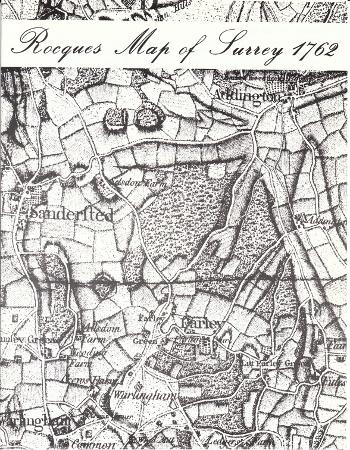
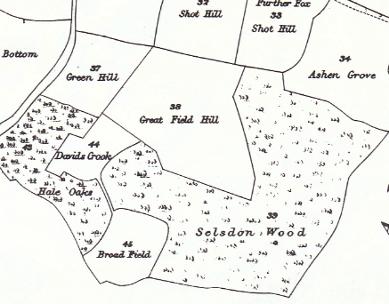
1800 - 1890
The estate comprising Selsdon Park, Selsdon Farm and Selsdon Woods was purchased by William Coles in 1809 but when he became bankrupt a year later it was sold to George Smith*, an MP, banker and director of the East India Company. The land was owned by the Smith family for most of the 19th century.
Thomas Langford was the tenant of Selsdon Park Farm from the mid 1870s until sometime between 1891 and 1895.
Smith transformed the farm house into a mansion (later to become the Selsdon Park Hotel) and made many changes to the estate, building a home farm complex, two lodges, a new farm and various cottages. He also landscaped the park and re-routed the Farleigh Road to the east.
There is little information about how the estate was managed but the woods would have been used for shooting and the fields probably as meadow or pasture as there is no indication that the land has been ploughed and the soil quality is too poor to support crops.
In 1883 the Corporation of Croydon was created as part of Local Government changes and “Croydon Crook’ became part of the Urban District of Coulsdon and Purley.
* George Smith (30 April 1765 – 26 December 1836) was a British Member of Parliament, banker and director of the East India Company. He was the fifth son of Abel Smith, a wealthy Nottingham banker, also an MP, and four of his brothers were also MPs. Smith entered Parliament in 1791 as member for Lostwithiel, and also represented Midhurst and Wendover in a parliamentary career spread over forty years. He was married to Frances Mary Mosley, daughter of Sir John Parker Mosley, 1st Baronet and they had 9 sons and 6 daughters. His memorial is in All Saints Church, Sanderstead.
see - http://en.wikipedia.org/wiki/George_Smith_%281765%E2%80%931836%29
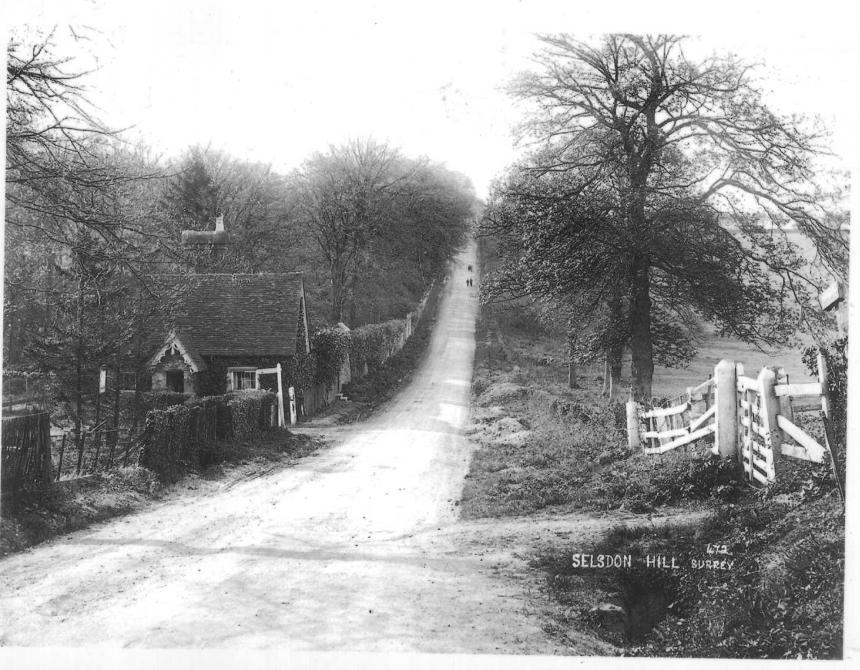
The photo above shows Old Farleigh Road (then called Selsdon Hill) - looking towards Selsdon. The cottage, Cosy Cottage, is still there at the junction of Kingswood Way and the white gate on the right is where the entrance to the Selsdon Wood car park now is. The exact date of the photograph is not known but the lack of development of smallholdings in what is now Selsdon Vale means that it is pre 1918. (Many thanks to Dick Adamson for this photograph.)
The photos below show a slightly later date as the road is metalled. These are taken from opposite directions with Selsdon Wood to the left of the top photo in the distance and to the right of the road in the bottom photo. Note that the top photo is captioned "Selsdon Hill" and the bottom one "Farleigh Road". (Many thanks to Richard Spurring for these photos.)
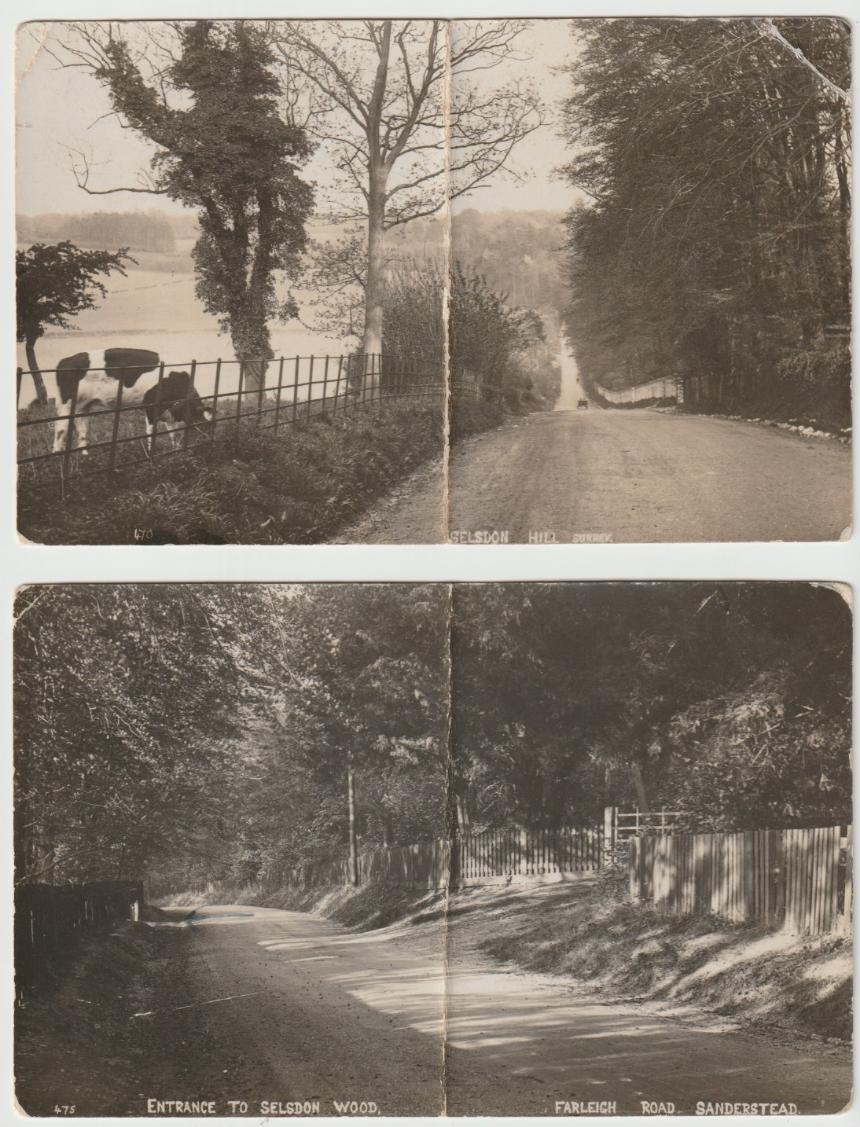
1890 - 1923
In 1890 Selsdon Park and farmlands (679 acres) was sold by Mabel Greville (George Smith's great-granddaughter) to William Stevens, a printer and publisher of a popular magazine The Family Herald. He is remembered for creating the plantation of conifers, Steven's Larch. On his death, nine years later the estate was sold to Wickham Noakes, a brewer, under a mortgage that remained until his death in 1923. During this period there was a grand shoot each year in November to mark Noakes’ birthday and a gamekeeper, William Westall, was employed to manage the land for shooting. Around this time Ordnance Survey maps show a ‘Pheasantry’ (where the young birds were raised) on the estate, situated on the western side of Old Farleigh Road, probably close to where Ravenshead Close now lies.
The aircraft I believe Jones was flying when he died was a French Caudron G.III, probably an E2 single seat trainer version, widely used by the RAF at that time for that purpose - it was an unarmed recon design under French manufacture but the RAF put light machine guns on theirs (likely Lewis guns) for air gunnery practice. The photo shows a generic shot of the G.III as a two seat French aircraft - quite a sizeable thing. There's a preserved G.III in the RAF Museum at Hendon. Below is a record of his death on September 22, 1918 and where Jones was lain to rest. Second Lieutenant was the entry rank for the RFC at the time.
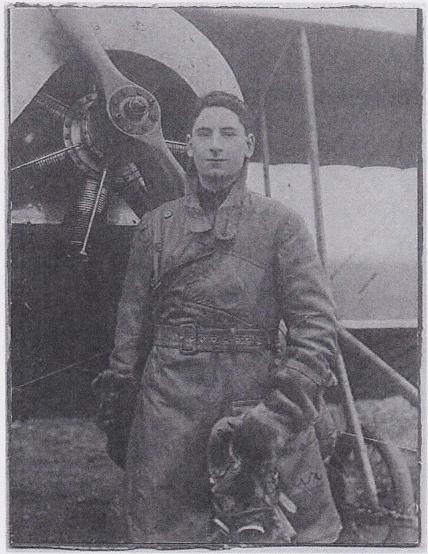
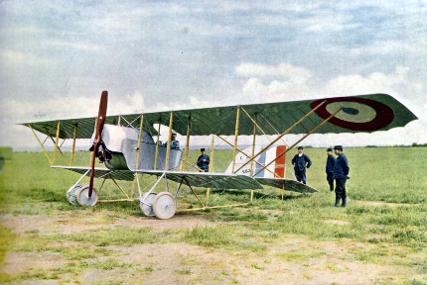
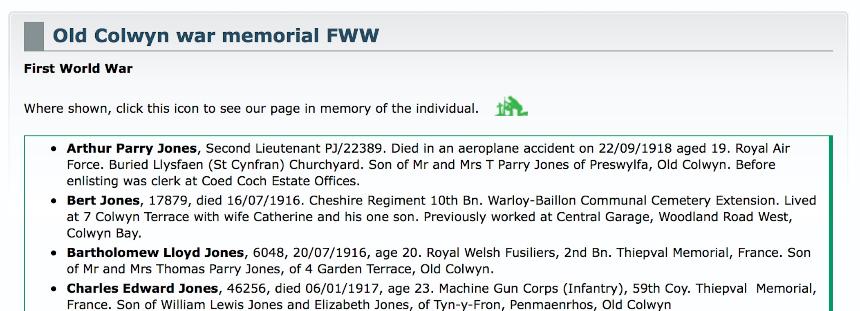
AIRMAN KILLED
Machine Falls From Great Height
A sad fatal flying accident occurred on the borders of the borough on Sunday. Sec-Lieut A Parry Jones of the RAF was piloting a machine over Addington ay a great height, when his machine crashed to earth, causing the instant death of the occupant. The aeroplane was smashed.
The deceased officer, whose home was at Colwyn Bay, was only nineteen years of age. His body was removed to Bandon Hill Cemetery, where an inquiry was conducted on Tuesday afternoon.
THE INQUEST
The Coroner for the Reigate District (Mr M J Nightingale) held an inquiry, without a jury, at Bandon Hill Cemetery on Tuesday afternoon.
The deceased airman was identified by a cigarette case which was found on him after the accident. It was stated that before joining the RAF the officer was an estate agent’s assistant.
Mr Willian Weetall of the Keeper’s Lodge, Selsdon Park, Selsdon told the coroner that at eleven on Sunday morning he observed an airman manoeuvring in circles. He turned round for a short while and all of a sudden there was a terrible crash. The aeroplane had fallen in Selsdon Wood. It was smashed to pieces and the pilot was dead.
The machine was seen to nose-dive by Frederick Belcher od Selsdon Villas, Selsdon. The witness said he heard firing which attracted his attention to the aeroplane. Whilst a gun was being fired the aeroplane dived straight to the ground.
Evidence concerning deceased’s injuries were given by Captain Iveson Russell RAMC who said the officer was out with the machine for firing practice. In the fall deceased legs were fractured and his body and head were extensively injured, the face was badly mutilated in consequence of a portion of the aeroplane having penetrated it.
The Coroner returned a verdict of Accidental Death.
(Croydon Times, 28th September 1918)
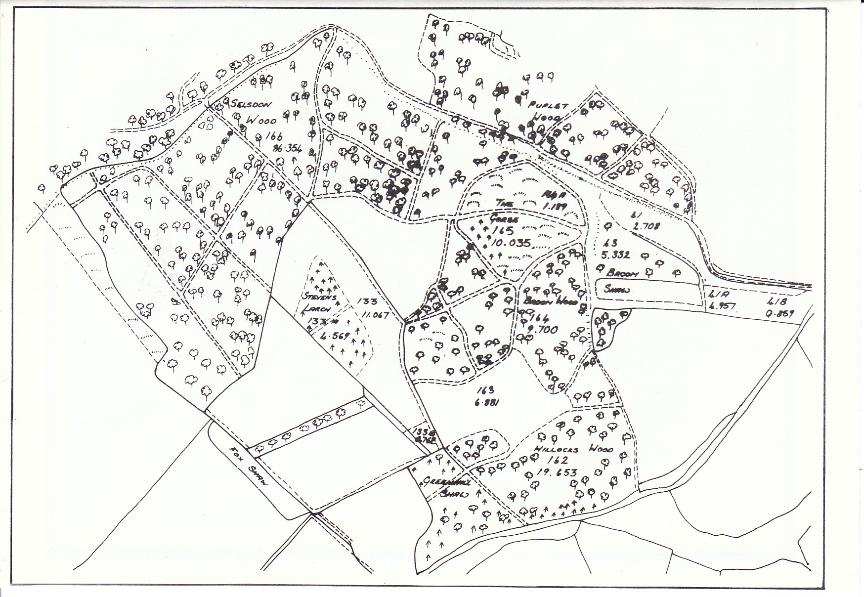
1923 - 1925
On the death of Noakes, in 1923, the estate was broken up with A. E. Cresswell purchasing the land that makes up most of the present Selsdon Wood. The map (above) extracted from the conveyance document is strikingly similar to the current map (although the orientation is different) and includes Selsdon Wood, Greenhill Shaw, Hillocks Wood, Broom Wood, Broom Shaw, The Gorses, Stevens Larch and four fields. However, Broom Shaw and Puplet Wood which are outside the boundaries of the present Nature reserve were also included at that time.
Of the remainder of the original estate, 200 acres of parkland and the Selsdon Park buildings were sold to A D Sanderson and became a hotel, and the Surrey Garden Village Trust (founded in 1920) purchased 300 acres including Ashen Vale and Selsdon Vale. This land was to be divided into smallholdings for sale to ex-servicemen from WW1. In return for their wartime work these veterans, who had served King and Country, were entitled to a plot where they could make a living off the land. In practise the plots were too small, and the land unsuitable for growing crops.
Although only one house was to be built on each plot the destruction of the original woodland had begun and in 1924 the local community began a movement to protect and preserve the Selsdon Wood Nature Reserve before it was all given over to building land. It was reported that "All principal timber, both in Lady Grove and Court Wood, has been removed...". Therefore moves were quickly made to protect the remaining area before the whole area was developed. It was not easy to raise the interest and funds needed and a lot of publicity was necessary to promote the campaign. Letters were sent to the local and national press and an appeal brochure was produced, enclosing a donation slip. Organised guided tours of the Wood were advertised and donations came in from all sources.

|
Telegraph from 1924.pdf Size : 427.208 Kb Type : pdf |
The success of the original appeal quickly raised the ambitions of the committee, to a total of just under the 200 acres held today. Having raised enough support to buy the land the committee then had to consider its future survival as an open space and its maintenance. One obvious custodian was "The National Trust for Places of Historic Interest or Natural Beauty". However, being voluntarily supported, The National Trust was unwilling to accept further responsibilities without appropriate endowment funds to cater for future maintenance.
The dilemma was resolved by the maintenance becoming the joint responsibility of the Croydon Corporation and the Urban District Council of Coulsdon and Purley, with ownership being vested in The National Trust.
1925
The further 1925 appeal aimed to raise £3210 to purchase Selsdon Wood as a “Proposed Bird Sanctuary and Nature Reserve'. The map and appeal form are shown to the right. The list above shows the second tranche of subscribers - the initial list cannot be found.
The appeal attracted much interest as this collection of press reports and letters show.
The photograph below - showing Steven's Larch see from the Langford's Way edge of the Great Field - was published in The Times on Tuesday April 28th 1925. My scanner will not handle the full width so some text has been lost. The heading is BIRD SANCTUARY FOR SURREY: THE SELSDON WOOD SCHEME. and the full caption reads:
VIEW IN SELSDON WOOD NEAR CROYDON, where it is proposed to establish a nature reserve and bird sanctuary. An appeal is being made for funds to purchase 107 acres of land at a cost of a little over £3,000. The estate is 12 miles from London, close to a rapidly-developing urban district. A special article discussing the project appears on another page of The Times today. (I am trying to get hold of this article.)
The photograph below shows the same scene today (November 2017). The tallest larches can still be seen but those in the perimeter are now masked by broad-leaved trees (mostly Oak) that have grown up in the intervening 93 years. The scrubby nature of the grassland also makes a contrast with the fields today which are cut annually.

|
Second Subscription List.pdf Size : 1831.492 Kb Type : pdf |
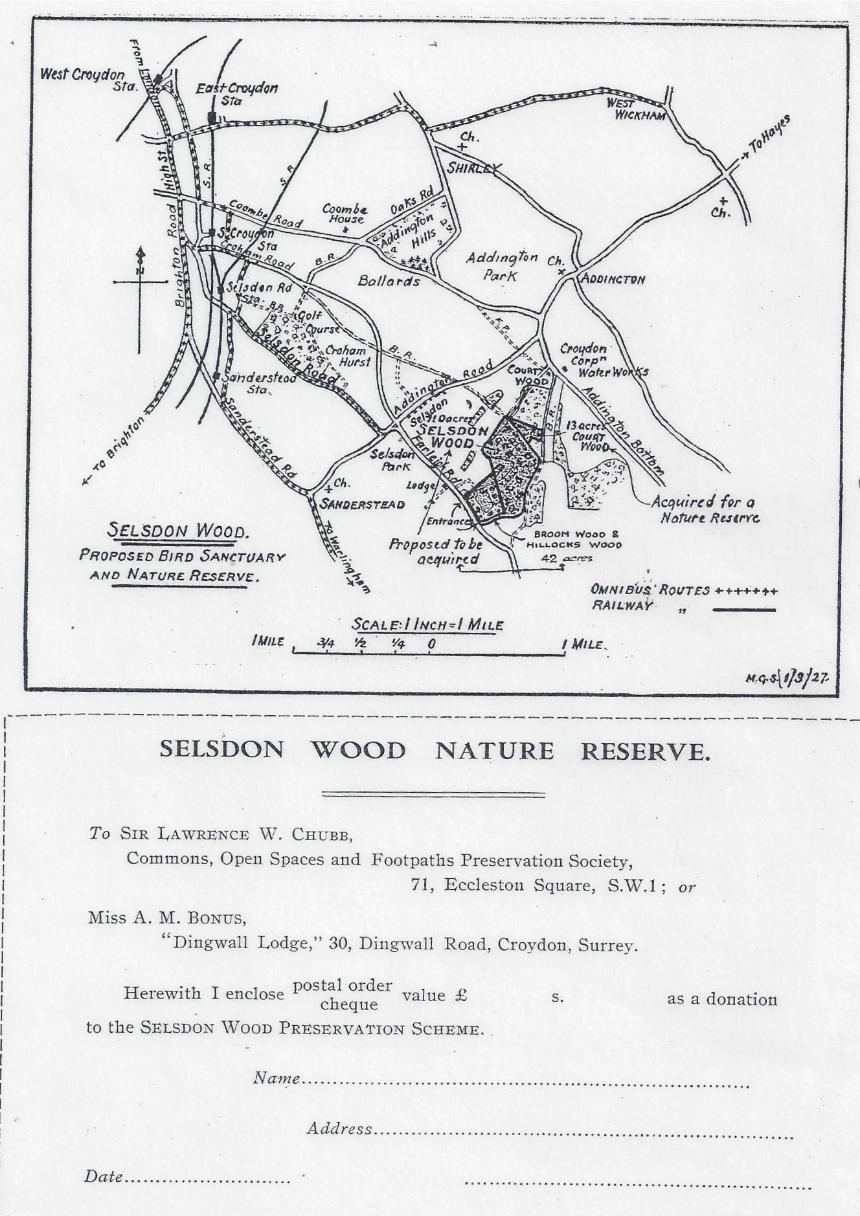
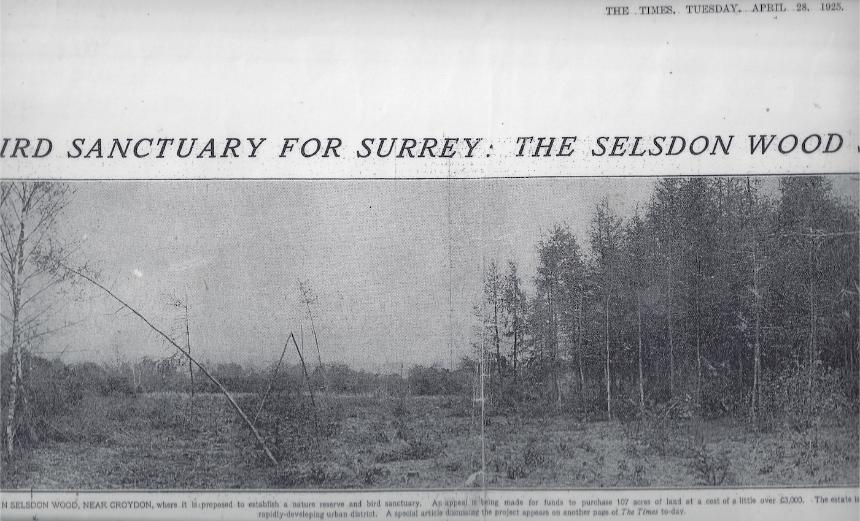
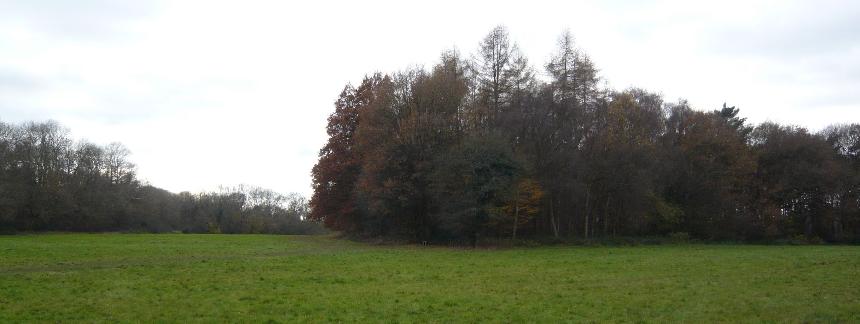

|
Saving Selsdon Wood - MG sharpe.pdf Size : 198.709 Kb Type : pdf |
1925-1930
Under the terms of the appeal, ownership of the land was to be vested in the National Trust (founded in 1895) with the Corporation of Croydon and the Urban District Council of Coulsdon and Purley jointly holding the wood on a 999 year lease and undertaking responsibility for its maintenance. In order to prevent the land being sold before the money could be raised a group of 5 philanthropists, calling themselves the Selsdon Wood Preservation Society, contracted to buy 126 acres of the most heavily wooded section on the north east of the site. These were
Mr Ernest Alfred Earl and Mr Malcolm Grahame Sharpe.
All their names are on the lease of 1935 - see below.
Another character associated with the purchase was Arthur Beadell - as this extract from the Bourne Society (see right) shows. See the link below it for his articles about wildlife in the woods. This series of 3 articles was published in the Croydon Advertiser in 1927. The first one, Wild Flowers of the Woods, cites many species which have not been seen in the wood in recent years, although the Herb Paris is still to be found close to the old Yews in Court Wood.
In 2022 Janet Sharp did some research into these individuals to whom we owe so much. Her findings were published in the Selsdon Gazette and are linked to the names above. A full list of all the Saviours of Selsdon Wood (and their famous relatives) and also the dates of the recent Selsdon Gazette Articles that give more details is given here.
In 1930 there was a further appeal - see the leaflet below - to raise £3000 to purchase the remaining part of the current reserve - a further 73 acres. Amongst the donors were Sir Julian Huxley, a local resident after whom the Selsdon Wetherspoons is named - see https://www.jdwetherspoon.com/pub-histories/england/london/the-sir-julian-huxley-selsdon
A map was produced as part of this, which is remarkably similar to the present Selsdon Wood 1930 (right). This shows the land on option, Sections III and IV, which include most of the fields, Greenhill Shaw, Hillocks Wood and Broom Wood. The map bears the initials MGS and was thus presumably produced by Malcolm Grahame Sharpe.
A shelter dedicated to the memory of Malcolm Sharpe - see 1973 below - stood in David's Crook until 2008 when it was burnt down by vandals. The wreck was cleared by LB Croydon the following year. The file below is a an obituary for Malcolm Sharpe published in the Selsdon Gazette in June 1948. This fulsome tribute shows his involvement in the protection of many other green spaces in the Selsdon & Sanderstead area in addition to his work for Selsdon Wood. (Thanks to Ted Frith for supplying this.) The summary of his work in Selsdon is given with his photograph in this briefer obituary - below.


|
Mr Malcolm G Sharpe tribute.pdf Size : 434.339 Kb Type : pdf |
This boundary marker (left) - which reads 'Croydon Borough 1928' can still be seen in the wood. It is set into a bank of flint marking the borough boundary which appears as a dashed line on the Appeal map on the south eastern side of Court Wood (Section 1). This follows the current Addington Border path. On the Croydon website it is noted that Croydon "... was enlarged by taking in the parish of Addington in 1928" - see here - this is presumably the significance of the date on the markers which denote the new Croydon boundary. Two similar markers are to be found in Littleheath Wood.
1935
As the appeal of 1930 had still not reached it's target, a group of local residents came up with a novel idea to raise further funds. They produced the Selsdon Wood Quotation Calendar. Residents paid 1/- to have their favourite quotations included and these were set out week by week on a separate page. Mr Hector Hutt prefaced each month with a brief paragraph of nature notes in italics.
The front cover is shown here and the 1930 appeal map (shown above) was used for the back inside cover.
The Calendar was priced at one shilling and 750 copies were sold raising £24.
One copy of the Calendar still exists and the owner, Ted Frith, has generously allowed it to be scanned for inclusion here. The high definition file is very large (40MB) but a 1.7MB version, which is still readable, is available from the link below. If you would like a high definition copy please get in touch with the Friends and we will be glad to supply it.
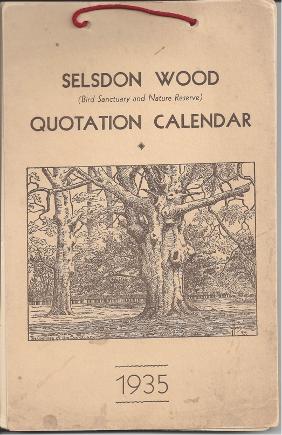

|
Village Histories extract.pdf Size : 822.483 Kb Type : pdf |
It is not known why such a far-off publication should have an interest in Selsdon Wood.

|
The Scotsman Tuesday June 4 1935 p11.pdf Size : 1600.823 Kb Type : pdf |
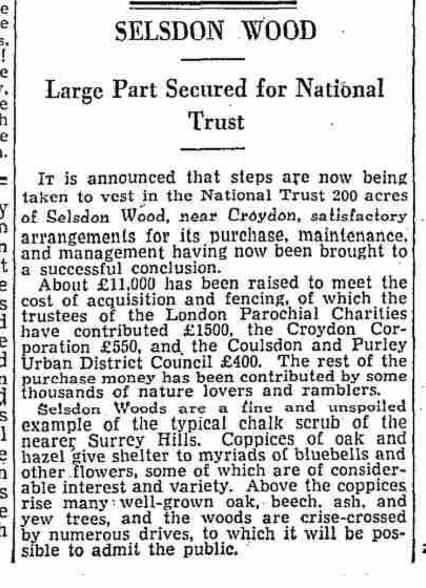

|
1935 Lease 1.pdf Size : 1858.223 Kb Type : pdf |

|
1935 Lease 2.pdf Size : 2291.718 Kb Type : pdf |
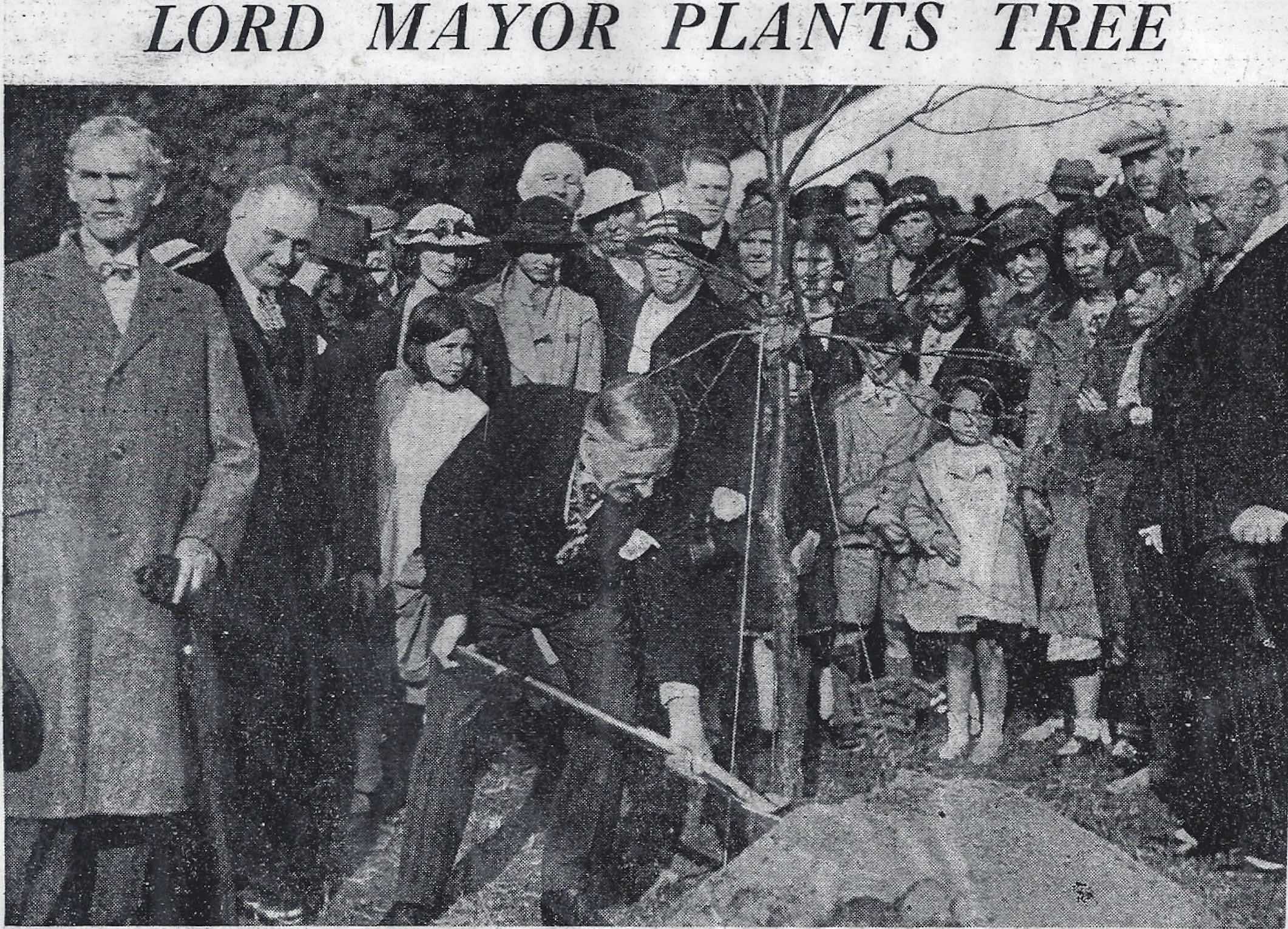

1936
A Deed of Gift (right) was made in November 1935 in which the owners (see 1925 above) formally handed the land over to the National Trust. On 5th June 1936 Selsdon Wood Nature Reserve and Bird sanctuary was offically opened by The Lord Mayor of London, Sir Percy Vincent, (who lived in Purley). Unfortunately the planned opening in the wood was cancelled as the paths were too muddy so the main event took pace at the Town Hall where over 250 guests attended the ceremony. Local Guides and Scouts provide a Guard of Honour and the Band of the 3rd King’s Own Hussars sounded a fanfare of trumpets. Later The Lord Mayor visited the wood and planted a tree as showing in the above photograph.
One of the major paths, Vincent Avenue, was named in honour of Sir Percy Vincent.
See the contemporary press report (right) for a full account.
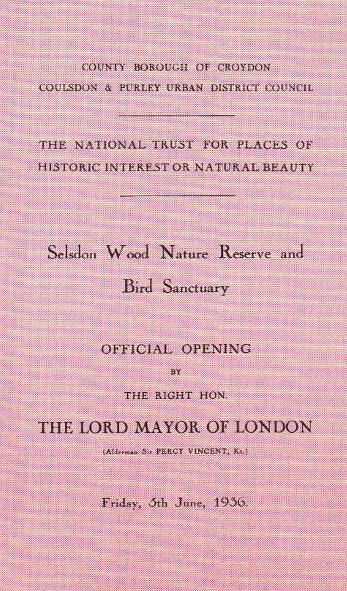

|
Officail Opening press account.pdf Size : 2137.694 Kb Type : pdf |
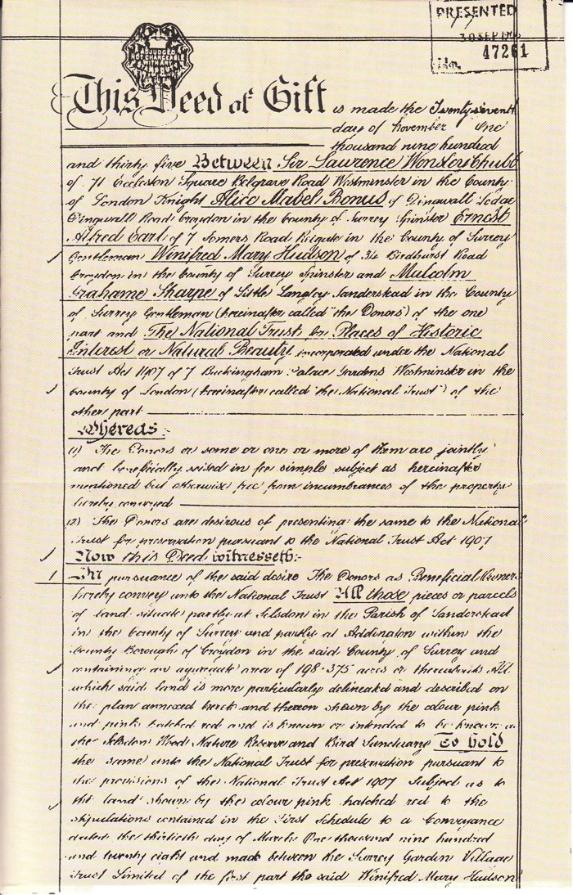
The National Trust Acquisition Directory
includes:
Selsdon Wood: Piece of land at Broom Wood, Farleigh
0.03 hectares (0.07 acres) acquired freehold on 10 October 1936 from the Warden and Scholars of the House or College of Scholars of Merton, University of Oxford
Selsdon Wood: Selsdon Wood Nature Reserve and Bird Sanctuary
79.304 hectares (195.96 acres) acquired freehold on 11 November 1935 from Sir Lawrence Wensley Chubb, Alice Mabel Bonus, Ernest Alfred Earl, Winifred Mary Hudson and Malcolm Grahame Sharpe
At the official opening visitors were invited to inspect the Memorial Bird Pool “kindly presented by Col. H.S. Wood, I.M.S.and Mrs Wood, of Kensington”. It appears that Lieutenant-Colonel Wood first suggested putting up a Bird Bath and Drinking Fountain as a Memorial to himself and Mrs Wood in correspondence with the Royal Society for the Protection of Birds in 1930.
In his will - written in 1948 - see below right - he asks that his ashes and that of his wife and his pet bird should all be scattered in front of the fountain.
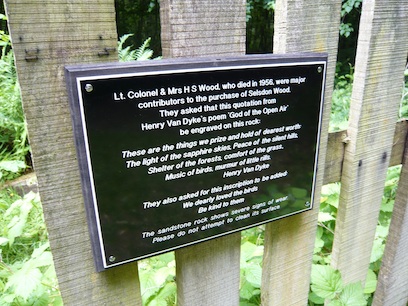
One of the Friends, Cecile Griggs has researched the life of Colonel HS Wood and the background to this donation. A pdf of her account can be downloaded from here. Lt Col H Wood and Selsdon Wood
Lt. Colonel & Mrs H S Wood, who died in 1956, were major contributors to the purchase of Selsdon Wood.
They asked that this quotation from Henry Van Dyke’s poem ‘God of the Open Air’ (chapter 6) be engraved on this rock:
These are the things we prize and hold of dearest worth:
The light of the sapphire skies, Peace of the silent hills,
Shelter of the forests, comfort of the grass,
Music of birds, murmur of little rills.
Henry Van Dyke
They also asked for this inscription to be added:
We dearly loved the birds
Be kind to them

|
Death Certificate of Harry Wood 15:1:56.pdf Size : 35.545 Kb Type : pdf |

|
Will of Harry Wood 15:3:48.pdf Size : 161.233 Kb Type : pdf |
The photograph below left shows the pool in the 1950s when it was fenced and had an adjacent bird table. The fencing was stolen and later the replacement wood fencing knocked down by dog walkers who thought the dogs should have some water source.
(Thanks to Pete and Denise Newbold - via John Zareba - for this photo.)
The one below right shows the bird bath and pool in Linden Glade as it was in winter 1986 when it froze. The bath was originally fed by mains water but this was cut off some years ago as it was considered too expensive to maintain.
(Thanks to Adrian Steel for permission to use this image from his Flikr collection - see http://www.flickr.com/photos/ade46/3854915841/)
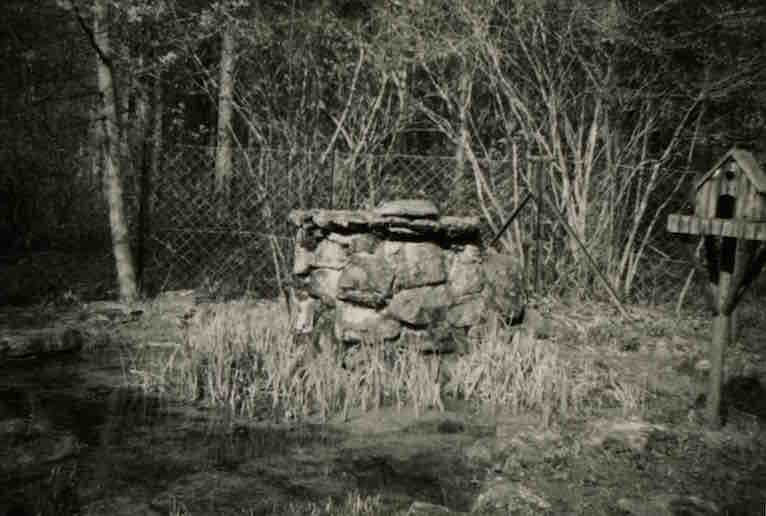
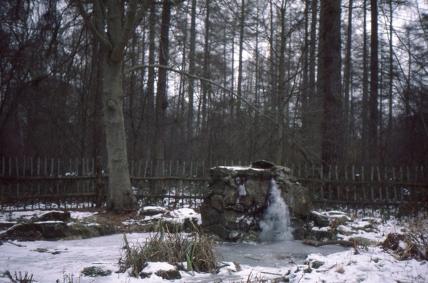
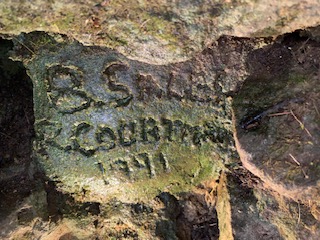
The War Years
During
1939-45 the Woods played their part in the War effort in several ways. In the
spring of 1942 the Great Field was ploughed by the Surrey War Agricultural
Committee, with the help of Italian prisoners of war. That area also
served as a decoy for Biggin Hill airfield and dummy tanks were placed with
their guns protruding from the trees.
1940
On 15th August 1940 bombs were jettisoned into the Wood leaving craters. Several of these can still be seen throughout the Wood, the largest of which is probably the one in Steven's Larch near to the Centenary Plantation. The link below is to an eye witness account of this event by Andrew Harris.
http://www.bbc.co.uk/history/ww2peopleswar/stories/57/a4678257.shtml
All the bombs that fell in London between 7/10/1940 and 06/06/1941 have now been
mapped and this map includes our wood see http://bombsight.org/?#14/51.3299/-0.0428. However, this period does not include August 1940 which may explain why
the many hollows toward the centre of the wood (that I have always assumed to
be bomb craters) are not marked on this map.
1950s
In 2015 the FSW received a communication from Chris Jennings who was a child in the 1950s living in a road called Selsdon Vale which flanked Vale Border. This was before the Selsdon Vale estate was built.
He recalled playing in Selsdon Wood and escaping from the two keepers (who carried shotguns) through a hole he had dug under the fence.
Click here to read the full memoir.
A further memoir was sent in by Steve Glover in 2016. He too had lived in Selsdon vale in the 50's where his father kept pigs and chickens on a smallholding called Ifra Tors. This provides another snapshot of a life very different from that of children today. Steve obtained a 1956 OS map of the area showing Ilfra Tors (grid ref 623/361). He estimates that the present day Goldfinch Road, Peacock Gardens and Lapwing Close now border the land.

I have just come across Angela’s - my late elder sister - poem which she wrote in 1976 (having emigrated to America in the mid ‘60s), 5 years after the passing of my mother and 17 years after my father died. It’s her reminiscences of our family pig and poultry farm called Ilfra-tors in Selsdon Vale, where we happily lived together from 1952 when my father retired from The Royal Marines up until his sudden death at the farm in 1959. I remember the valley in which it was set and the glorious surrounding countryside which formed part of the ‘Green Belt’ at the time (meaning the land was protected and could never be built upon - somewhat ironic as things subsequently turned out). Not long afterwards, the farm and land were sold and all of it disappeared under the present day ‘Bird Housing Estate’ off Old Farleigh Road by Selsdon Wood.”

|
Ilfra Tors 1956 OS Map.pdf Size : 365.763 Kb Type : pdf |

|
1958 Map.pdf Size : 1082.423 Kb Type : pdf |
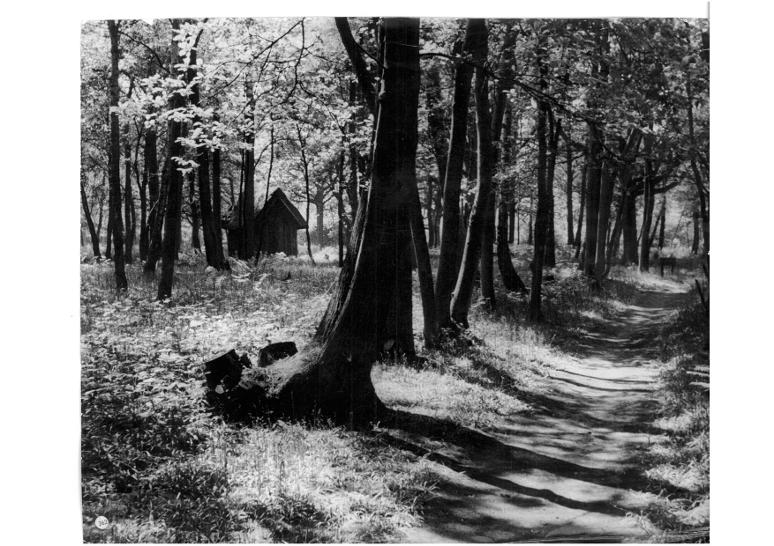
A point of potential interest told to me by my father was that the first live radio broadcast of a nightingale singing was recorded from Selsdon Woods. I wonder if this is correct?

|
Gazette September 1962.pdf Size : 1142.566 Kb Type : pdf |
Selsdon Vale and Forestdale
estates were built. Town
Planning regulations stipulated that a buffer of open space should be
left to
protect the woods. The area on the Selsdon Vale side, Fox Shaw, (see map below) is 150
feet
wide and has been acquired by the local authority although it is outside
the
boundary fence of the wood and is not part of the National Trust
property. On
the Forestdale side the ‘open space’ is now mainly formed by the gardens
of the
adjoining properties. On the North-East edge of the wood the a 200ft strip of woodland beside the bridleway is owned by Brookscroft Woodlands Ltd (a consortium of Brookscroft residents) and the adjacent section, owned by Cascades Management, is mostly lawn.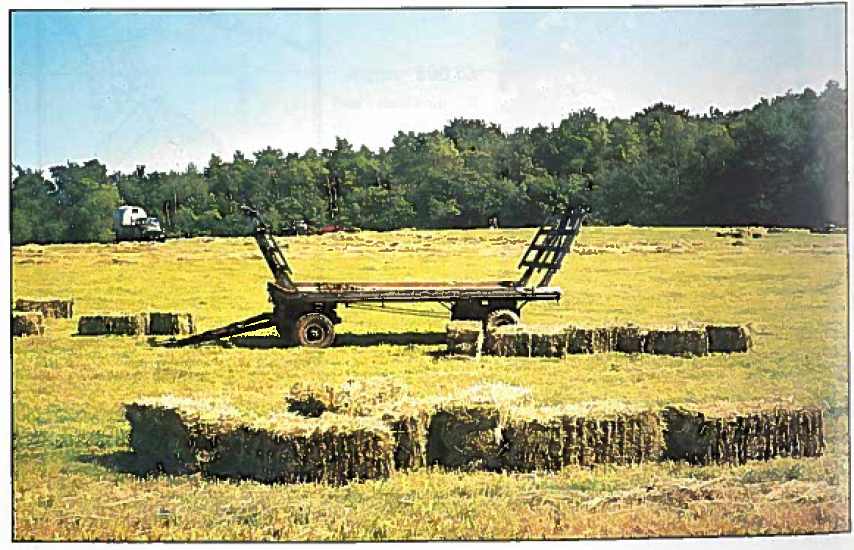
In 1965 the reorganisation of Local Government amalgamated the two councils into the London Borough of Croydon. Demand for timber in wartime and post war building had resulted in many areas of the wood being reduced to a scrubby thicket with poor tree coverage and consequent limited wildlife. A complete survey was undertaken by the new authority and replanting was recommended.
The first section was replanted in 1969. Over the next 25+ years
beech, oak, sweet chestnut, larch and Norway spruce were planted throughout the
wood with the coniferous planting mainly in the early years.
To maintain the flower rich chalk grasslands, the five meadows were cut annually by a local farmer who was paid for the work by keeping the hay for his animals. This photograph entitled 'Taking a Hay Crop from One of the Meadows' comes from a book called "Croydon Parks - an Illustrated History".
1973
A brick shelter was built in the south eastern corner of David's Crook to replace the rustic thatched shelter that was burnt down (see 1957 above). Like it's predecessor, the shelter was dedicated to the memory of Malcolm Sharpe (see 1925 and 1957 above). It stood until 2008 when it too was burnt down by vandals. The wreck was cleared by LB Croydon the following year.
Illustration by David E Holmes originally published in LB Croydon Parks Department Woodland Ramble (1980 Revised Edition)
The file below is a report by Tom Price of the on site meeting of the Selsdon Wood Management Committee. It was published in the Selsdon Gazette in August 1973. (Thanks to Ted Frith for supplying this.)

|
Selsdon Wood Management Meeting August 1973.pdf Size : 263.34 Kb Type : pdf |
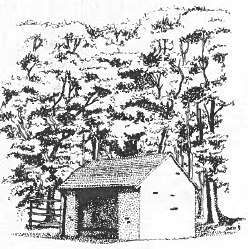
1974
The LB Croydon Parks Department published a map in 1974 showing the areas newly planted since 1968. These included Steven's Larch, Greenhill Shaw, the Gorse area and the region near the Gorses on the other side of The Wend. The map also shows 3 Special Sanctuaries and the new housing developments surrounding the wood with the Fox Shaw buffer zone marked.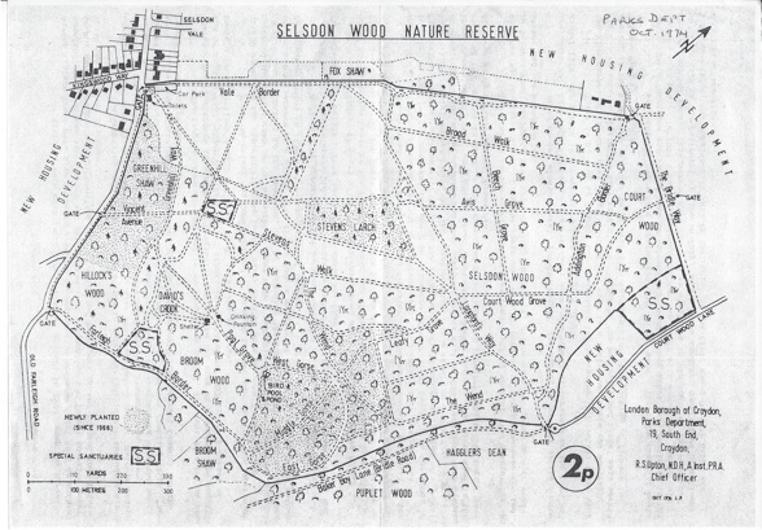
1977
The Jubilee Plantation was created to celebrate the Queen’s Silver Jubilee. This includes oak and beech and was funded and planted by the Croydon Girl Guides.
(See Areas of Special Interest page for photographs and more information about the Jubilee, Maruje Dale, and Centenary Plantations.)
In the same year LB Croydon Parks Department published a pamphlet 'Woodland Ramble' describing a walk through a number of the local parks and woods including a section on Selsdon Wood.
1979
The Maruje Dale Plantation was created by a group of young people on a Youth Opportunities Scheme organised by Gordon Alexander of Croydon Council Parks Department. The name of the plantation was made up from the names of those who took part. During their training they covered coppicing and maintenance work and they were taught how to make benches and bird boxes with the wood. New trees were also planted - mainly beech.
The plantation was protected by rabbit-proof fencing but a gateway was made for badgers to allow access along their well used tracks between the set and feeding grounds. This had a sprung gate, heavy enough to prevent the entry of rabbits but allow the larger, stronger badgers to pass freely.
Badger Gateway Illustration by M.J Currie originally published in LB Croydon Parks Department Woodland Ramble (1980 Revised Edition)
1983
The Centenary Plantation was created to commemorate the
centenary of Croydon Council. One hundred English Oaks and Birch trees were planted with the intention that the Birch would be felled when the Oak had matured.
The scheme was originated by Croydon Councillor, Dudley Mead and was paid for by public subscription by Selsdon residents. In Selsdon library there is a book containing the names of all who subscribed (£5 per tree - quite a lot in 1983).
1986
Three oaks were planted by
the Mayor of Croydon in the Southern corner of David's Crook to mark the 50th
Anniversary of the Official Opening. A plaque marks the site - see below.
This photograph of the event (right) was originally published in the Croydon
Advertiser. Many thanks to them for permission to use this image.
A booklet, ‘Selsdon Wood Nature Reserve - An Illustrated History’ was published to celebrate the 50th Anniversary of the Opening of Selsdon Woods in 1936. Most of the maps and other illustrations on this page are taken from this booklet.
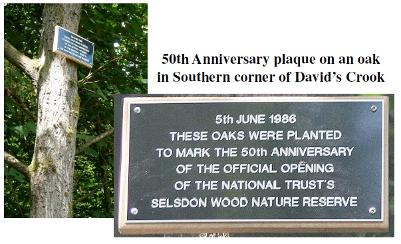
1987
This piece from the Croydon Advertiser of January 1987 highlights another contribution from a volunteer group - The National Trust Activities Group. It is not known for how long this continued but there was no long term voluntary activity in the wood in 1987.
At this time two keepers were employed and their duties included patrolling, pest control, care of toilets and car park, as well as forestry.
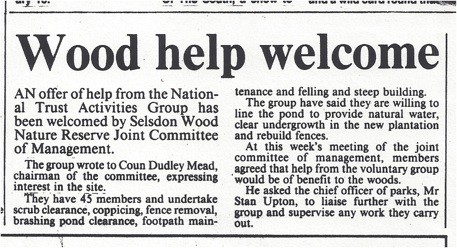
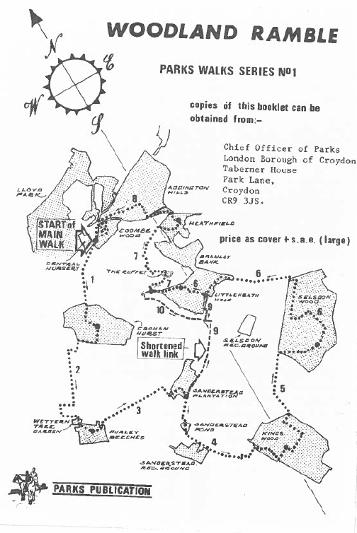
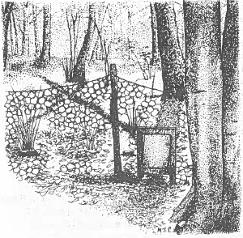
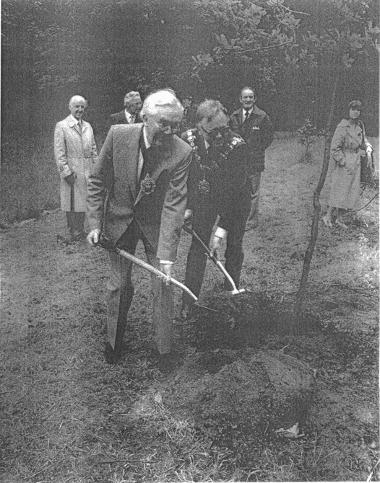
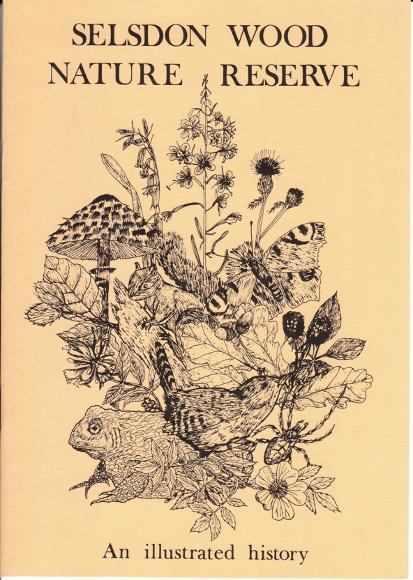
The bear that stands beside the car park was carved in the first year (1988) as a spectator event during the show. It was carved by a local tree surgeon, Selwyn Smith who now lives in Wales.

|
The Croydon Country Show.pdf Size : 194.243 Kb Type : pdf |
2003 - Founding of SWAG
A support group, SWAG, the Selsdon Wood Action Group, was set up. The constitution was drafted at meeting on 8th November 2003 following an inaugural meeting held possibly in September/ October that year.
SWAG notice boards were put up at Kingfisher Gardens and Quail Gardens gates. (These had rotted and fallen off by 2015 when they were replaced by new FSW boards.)
It is not known for how long SWAG was in action. Please get in touch if you can tell us more.
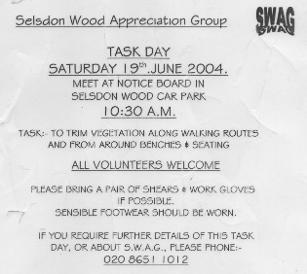
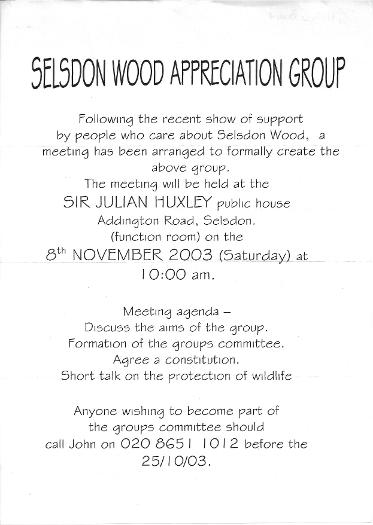

|
Constitution of SWAG.pdf Size : 1297.997 Kb Type : pdf |
2007 - FSW Founded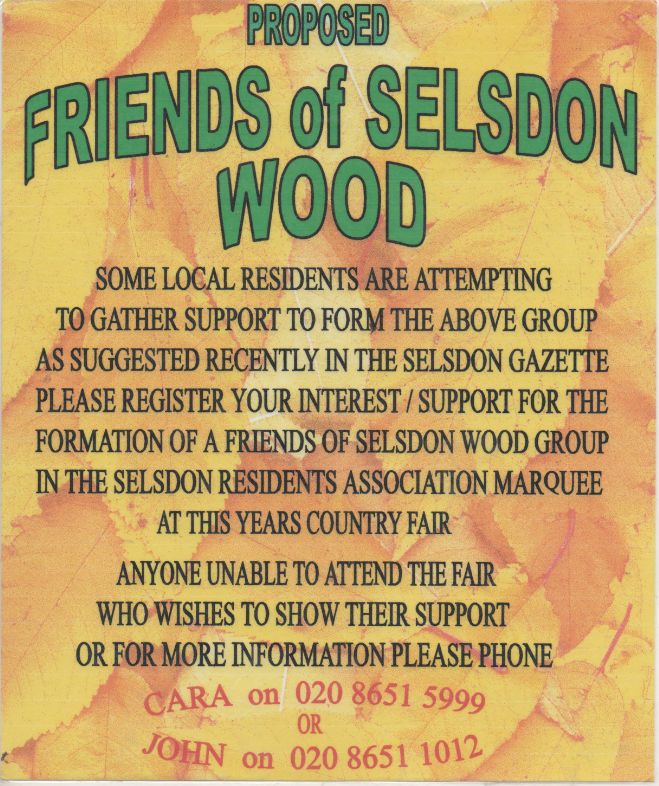
The Friends of Selsdon Wood was founded by Dawn Gibbons (who had also been involved with SWAG, which had folded. The inaugural meeting was held on 12th November at the Julian Huxley, Selsdon. The event was attended by 12 people including Ernie Thomason, the Park Ranger, Meike Weiser, the Community Partnership Officer and Sara Bashford, the Selsdon Councillor responsible for Woods. There was also a representative of Selsdon Residents Association attending. At this meeting it was agreed to set up a Friends group to maintain and promote the wood.
The picture below shows the cover of the Selsdon Gazette of April 2008 with photos of the spring anemones in Selsdon Wood and the bluebells in King's Wood. The painting on the right is by Len Hazell.
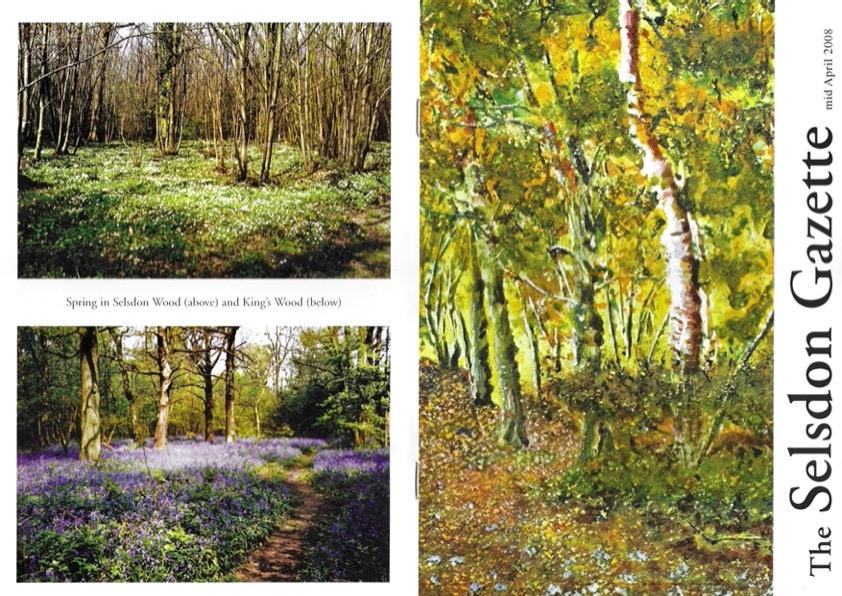
2008
In the summer of 2008 the FSW published our first newsletter - the Leaf Letter. It tells of the formation of the group and the first guided walk at bluebell time, led by Ernie Thomason who was the Park Ranger for the wood. An amazing 70 people attended the walk! The newsletter also provides dates for the diary including the first Open Day on 7th September.
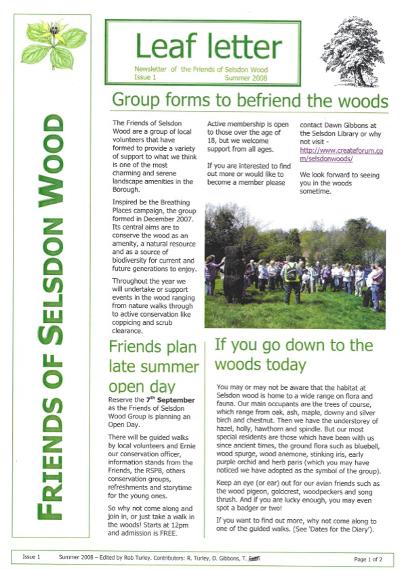
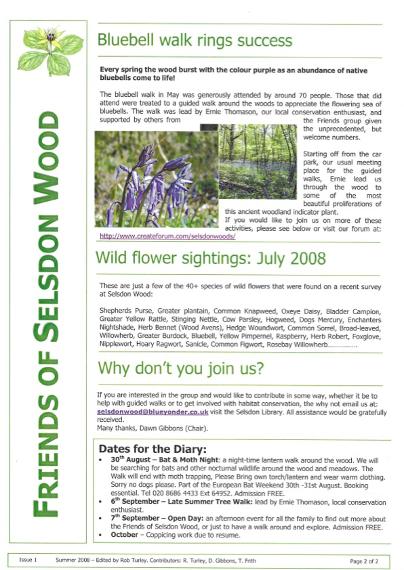
2008 - NEWS FROM THE FRIENDS OF SELSDON WOOD - 7th September
Despite a very soggy start to the day, the Friends held a very successful first Open Afternoon in Selsdon Wood on Sunday 7th September. The event was visited and enjoyed by about 150 people - not only 'locals" but some visitors and helpers from outside the area too. The stalls set up by the library (story-time for the under 10s, badge making and Breathing Places) RSPB and the Badger Protection Society were well supported and the S Croydon Scouts kept everyone well provided with tea and scrumptious cakes. The Park ranger led two walks for those who wanted to find out more about the flora and fauna of the wood.
The Friends stall had a display of what they had achieved so far, copies of the newsletter (which has also been displayed on SRA notice boards) and a prize draw. The prizes had been donated by some Friends and a few Selsdon businesses (JS Sainsbury, J D Wetherspoon, Gardencraft, Barclays Bank, Touche, Tudor Library and Aphrodite) for which support we are very grateful. Likewise, we thank all those who purchased the draw tickets - we raised over £100 from this venture which we ill now decide how to spend to improve the Selsdon Wood environment.
We also recruited some new members to the group and we hope that others will join us as a result of seeing what we are doing. We welcome any new Friends to our monthly meetings or the work sessions in the Wood. The meetings are held on the last Monday of the month from 8-10 pm in the Forestdale Forum and the work sessions so far planned are to be held on the first Sunday of the next 3 months. If you would like to join us for these than please pay your subscription (£5 per family) so that you are covered by our insurance and then meet us in the main Selsdon Wood car park at 10.30 on Sunday 5th October, 2nd November and 7th December. We provide the basic tools but you need to bring your own protective clothing and shoes and some sandwiches and a flask to keep you going. We hope to work until about 2-2.30pm - more or less, rain or shine!! Latecomers will find us in the wood by listening for the sound of our activity!! First work targets are to clear areas around the benches - the Friends' efforts to draw attention to the state of the wood have now been recognised as the Council have offered some new benches so we need spaces for those.
If you need any more information please leave a message on 020-8405-1850 and someone will call you back or have a look at www.createforum.com/selsdonwoods or email selsdonwood@blueyonder.co.uk . You can also make contact via the Breathing Places representative, Dawn Gibbons (who is also Chairman of the Friends group) at Selsdon Library.
2009 - The Work of FSW to 2009

|
Work of FSW to 2009.pdf Size : 139.44 Kb Type : pdf |
2009 Forestry Commission Report on Selsdon Wood Management Plan
This report - available from the link below - provides much interesting information including a summary of the history of the wood and lists of species found in the various different environments.

|
Forestry Commission report 2009 eng-gr-exampleplan-selsdonwood.pdf Size : 393.076 Kb Type : pdf |
2010 - September 10th
The Croydon Advertiser published a report of the FSW 2010 Open Day - the third held by the group.
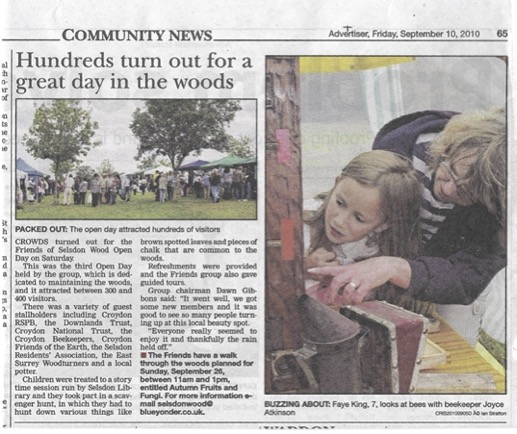
2010
The Friends of Selsdon Wood obtained grants to purchase name boards for the woodland paths - £500 from the London Tree & Woodland Grant Scheme and £500 from the Selsdon Residents Association. The Friends added £75 to allow the first two phases of the project to get under way. For more information and photos see the Projects page.
The FSW also did some clearance work in the Jubilee Plantation and planted 250 mixed whips. For a full account see the Areas of Interest page.
2011
The 75th Anniversary of the opening of Selsdon Wood as a National Trust Nature Reserve was celebrated with a charcoal burn over the weekend of June 3rd, 4th and 5th. A similar event was held in May 2012. Details of these charcoal burns can be found on the Events page.
2012
On 3rd March groups of Brownies and Rainbows planted 60 trees in the Jubilee Plantation to celebrate the Queen’s Diamond Jubilee. See Areas of Interest page for photographs and more information about this event.
2013
On 7th August the Friends of Selsdon Wood installed a new seat at the top of
Green Hill, donated to commemorate the establishment of the FSW in 2007. We
also attached a lost property box to the notice board in the car park.
A dedicated bench was also installed this summer in Field 2 in memory of
Heather Creamer, a lover of Selsdon Wood, who died in December 2012.
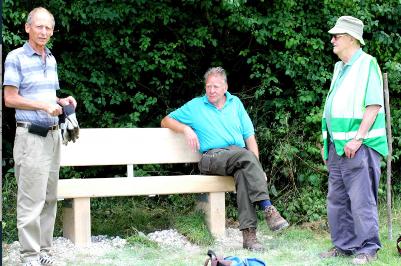
2014
In the summer of 2014
Croydon Council installed raised banks around the car park area. These are
called soil bunds and replace the wooden posts that had largely rotted away.
Their purpose is to prevent the possibility of invasion of the woods by
travellers or other vehicles. They are better deterrents than posts (which can
fairly easily be knocked down by a determined intruder) and are also a more
permanent solution to the problem. They looked a bit messy when first built but
they soon grassed over and in future years will be mown at the same time as the
field paths to keep them neat.
The photograph shows the soil bund on 16/8/14 - only 2 weeks after completion and seeding.
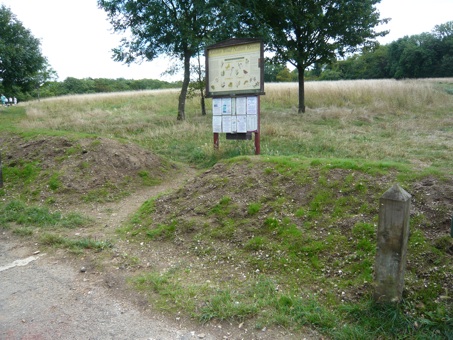
The Council installed two new bins in
the car park - part of a programme of renewal of 130 bins borough wide. These
have no separate slot for dog poo - it all goes in together - and there is a
cigarette stubber on the top. It is hoped that the slot is
narrow enough to prevent the dumping of household waste and to stop foxes raiding
the bins and spreading mess. So far this has proved to be the case.
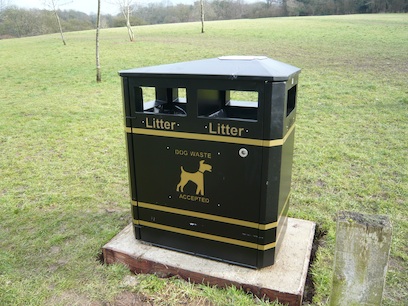
2014 - 2015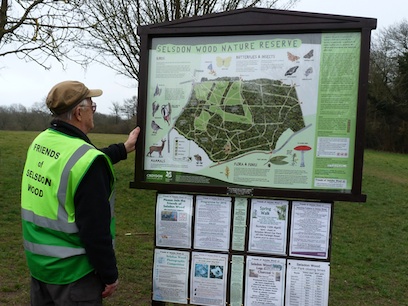
In 2014/15 FSW undertook the renovation of the notice boards at the 6 entrances to Selsdon Wood. They had been up for 20 years or so and contained out-of-date information and had also been damaged by graffiti. Although the boards were Council owned they were unable to fund any work on them in the current financial climate. The FSW were able to obtain grants to cover most of the cost and in February 2015 the first completed new board was erected in the car park. The project had taken 18
months. For a full report see the Projects page.
2015 March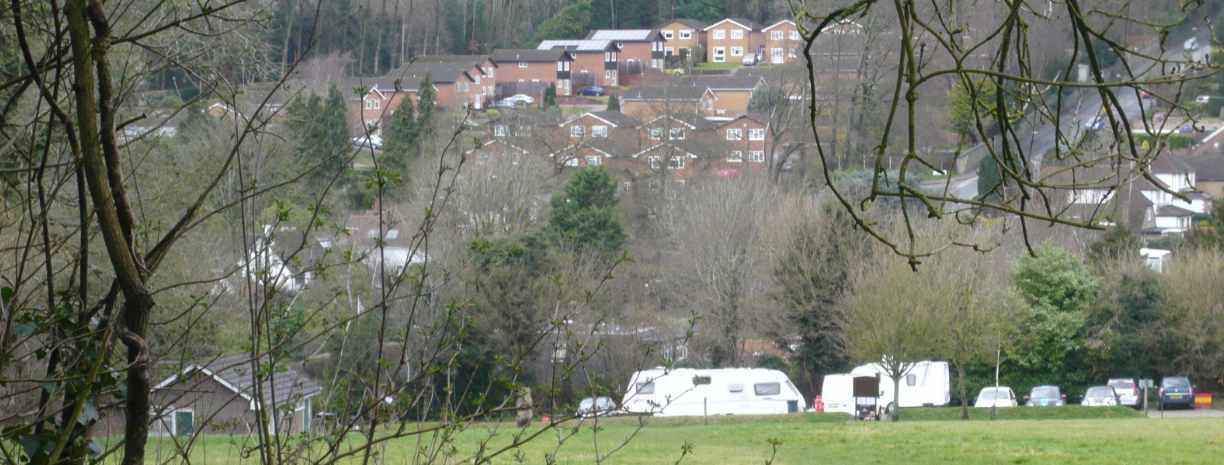
On 25th March we had some unwelcome visitors - 3 travellers' caravans in the car park, It was reported to the police and Council who were aware of them as they had previously been in Selsdon rec. then Selsdon Park Hotel staff car park. They were moved on by bailiffs on 27th March. They had made a bit of a mess but it was cleared by the following day by Council contractors and the FSW.
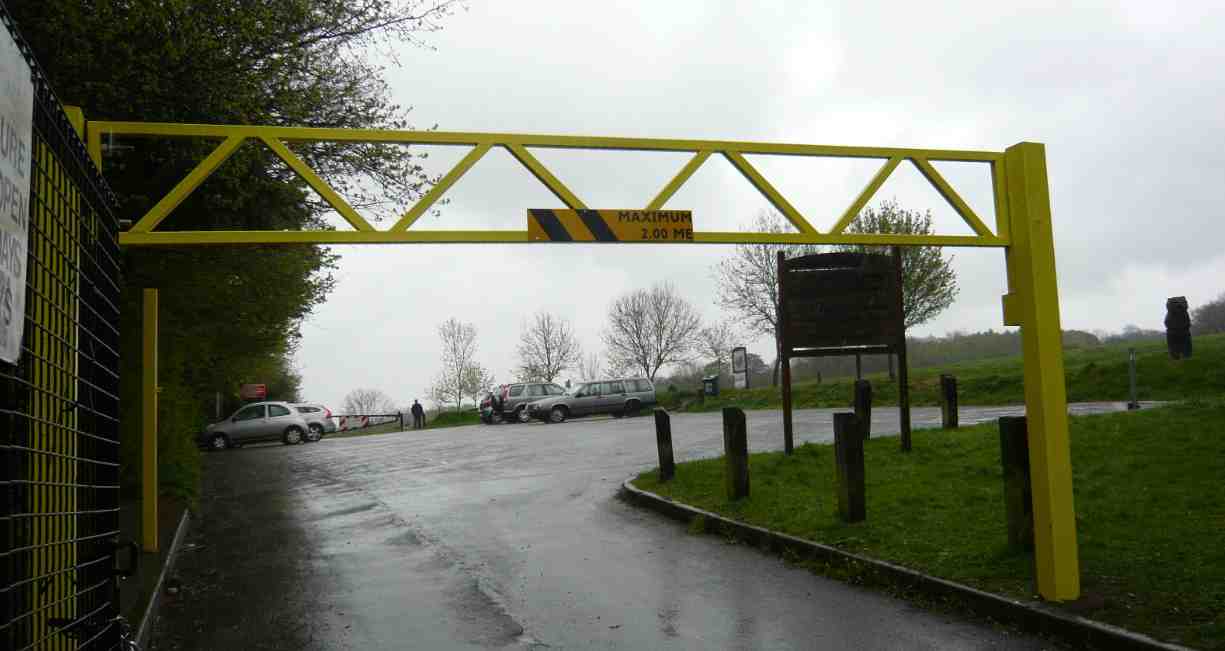 2015 April 28th
2015 April 28th
2015 Eight New Benches
During the month of April five new benches were installed in the wood by the FSW. Two were to replace old benches that were rotten and three were dedicated benches in new locations. The latter comprised benches dedicated to the memory of woodsman Rob Sowter and to Janet Bickerstaff (a founder member of the FSW), both presented by the FSW, and a bench for G G Lewis presented by his friends and family. For more details and photographs see the Projects page.
A further 3 dedicated benches were installed in the autumn of 2015 to commemorate the lives of Michael Boyd, Vera May Cannon and Jan Stupes Martin. All were presented by the families of the deceased. Full details can be found on the Seats page.
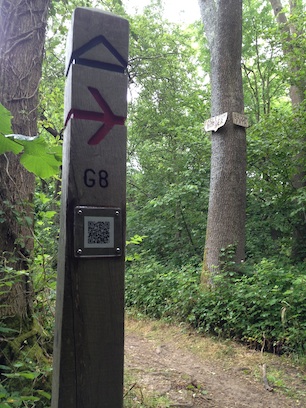
FSW set up two trails in Selsdon Wood which are accessible on a mobile phone by way of QR codes. These codes are square patterns of dots which work in much the same way as the barcodes used for stock control in shops. For many years there have been two trails (red and green) both marked by wooden posts and starting at the car park. The numbered posts on each route now have QR codes attached and if these are scanned with a smartphone they display pages of seasonal information about the trail and an accompanying map. The original paper guide and the QR trails may also be accessed from the Walks page. If you use the QR trails we would be very interested in your feedback - do please get in touch via phone, email or website.
To access the pages revealed by the codes click these links.
2015 June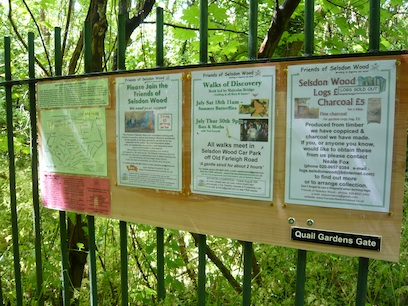
In June 2015 new nesting boxes and plaques were installed by FSW. These included bird and bat boxes made by Jim Dunning and plaques in Linden Glade (see 1936 above) and The Gorses.
The old SWAG (Selsdon Wood Appreciation Group) notice board at the Kingfisher Gardens gate was replaced with a new board for the FSW notices and a similar board was sited at the Quail Gardens gate. (See 2003 above for more about SWAG.)
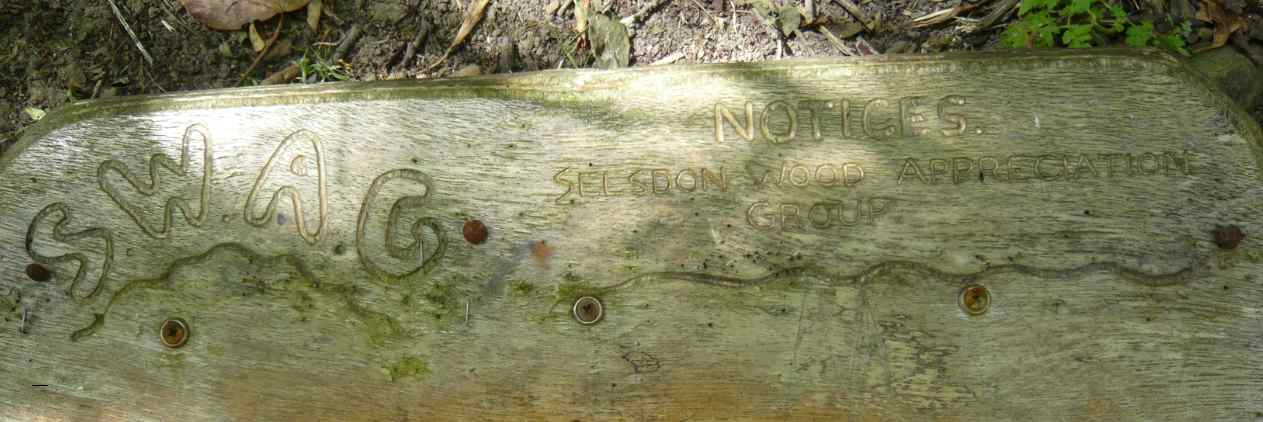
2015 August - Redecoration of the Toilet Block
Contractors
for the Council started work on this on Saturday 22nd August 2015 and
by Tuesday 1st September the internal work was completed. All internal
walls were painted white, the floors resurfaced in grey and external doors painted
green. The door to the Ladies was replaced as it was very rotten at the base. FSW had to move out of our store to allow it to be painted and all our resources were relocated temporarily to the garage. They were returned to the store on 3rd September.
On completion of the work the FSW applied to Croydon Council for a licence to make use of the "mess room" which had been largely unused since there ceased to be a full time warden. Thanks to funding from the local Councillors' Ward Budget we purchased a display board which is installed in the mess room and bears a series of displays linked to events and walks. These displays also include a "museum" of items found in the wood such a the skulls of various mammals.
2016 May - FSW win Community Woodland Award
The Friends of Selsdon Wood were delighted to receive an award from the Forestry Commission for being a community group that works effectively to protect and develop London's trees and woodland. The group was nominated by Mathew Frith of London Wildlife Trust and attended an event at London City Hall on 26th May 2016 to receive the award.
Click this link for full details of the nomination and an account of the ceremony.
2016 - FSW Restoration of Linden Glade
In 2016 the FSW held several additional workdays to clear and restore the pond in Linden Glade and to create a wooden henge to replace the broken down fence. Unfortunately the pool sprung a leak in the following year which we were unable to cure. Full details of this work with photographs can be found on the Projects page.
2016/2017 - FSW Muddy Puddles Project
Over the period of 2016-17 the FSW laid woodchip and gravel to improve the quality of many paths and get rid of the worst muddy puddles. Full details of this work with photographs can be seen on the Projects page.

Storm Eleanor blew down a huge Oak tree on Farleigh Border. The tree was entirely blocking the path and was much too big for the FSW to deal with so we reported it to the Council who had it cleared the very next day. Measurements of the girth of the trunk suggest that the tree was around 120 years old.
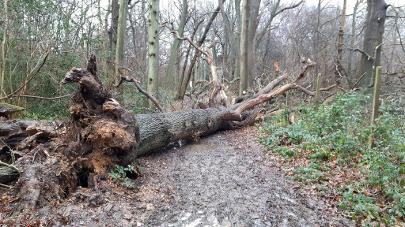
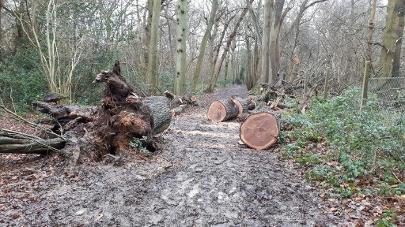
A policy for installation of future seats and benches was agreed. In the main body of the wood and fields there will normally be no new benches or seats - only replacements for any rotted or damaged ones. The installation of any new benches and seats must be justified to the FSW Committee and Croydon Council. New dedicated benches, if and when more are offered, could usefully be placed along the London Loop and at the North East end of the wood.
We met with Council representatives in September to discuss the role of the FSW and our relationship with the Council. Our policy for seat/bench installation and a strategy for our coppicing work were agreed.
Tired of finding of dog poo bags hanging on trees or thrown into bushes the FSW started a campaign in the spring of 2019 to persuade the Council to install more poo bins. This was supported by many users of the wood who lobbied the local Councillors. They were persuaded and the Council installed new bins at 4 key sites - the gates at Yew Tree Way, Cascades, and Vincent Avenue and also at the exit from the car park field on Vale Border. We have also put up many posters encouraging dog owners to “bin it or flick it”.
However, our Workdays Team continued to work in small, Covid-safe groups at times convenient to them - see the Workdays page for details.
2021 - Butterfly Bank
The Brilliant Butterflies Project was set up in 2021 and worked with Croydon Council and local communities to create more wildflower areas for butterflies and other insects. They selected a site in our car park field on which to build a Butterfly Bank. The intention was that when the Project ended in 2022 the maintenance of the BB would be taken on by FSW.
They created a chalk bund in our car park field on 19th April 2021. Low nutrient chalk provides excellent conditions for wild flowers. On Sunday 25th April this was sown, by FSW volunteers, with butterfly friendly seeds and planted with 250 small plug plants of various wildflower species (Birds-foot Trefoil, Cowslip, Knapweed (greater & lesser), Ox-eye Daisy, Rock-rose, Scabious, Thyme and Yarrow) to supplement the chalk grassland seed mix. This will help support many species including the Small Blue Butterfly. See the Butterfly Bank page of the website for further details of the establishment and maintenance of the BB.

2023 - 2025 - Restoration of the Linden Glade Pool
The Linden Glade Pool had been in a poor condition for some years and the previous attempts by FSW to restore it had not been successful. In late 2022 the FSW were approached by a family who were interested in supporting us to undertake a restoration in memorial of family members who had loved the area. Initial work commenced on 23rd April 2023. See the Projects page for further details.
September 2025 - Instalation of Defibrillator
The Rotary paid for a Defibrillator to be fitted to the toilet block. This was installed on 4th September 2025 and officially opened by the Rotary at the Selsdon Community Fair on 7th September.

The History of Selsdon Wood Up to 1945 by Ted Frith
Janet Bickerstaff wrote a Project in 1986 for the Open University Changing Countryside Course on the History and Management of Selsdon Woods. She kindly gave permission for us to publish this and a copy may be downloaded from here.
History and Management of Selsdon Woods
See also the page on Selsdon Wood Nature Reserve History from the LB Croydon Leisure and Culture website:
